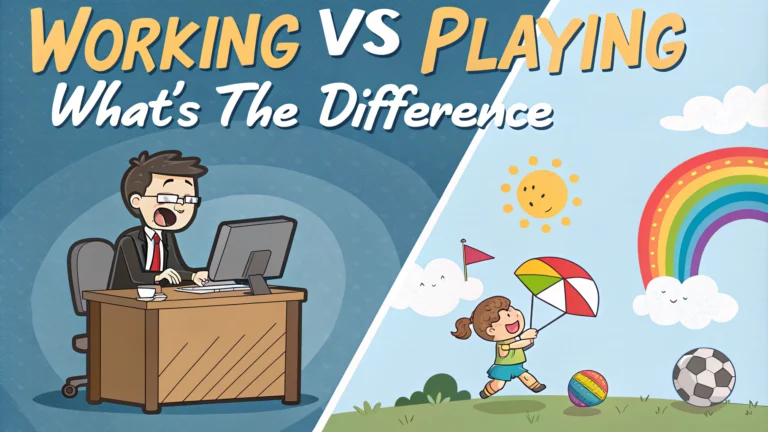The distinction between working and playing shapes how we experience life and achieve personal growth. A clear understanding of these activities helps create better boundaries and leads to improved productivity and satisfaction.
Work and play serve different purposes in our lives, yet they share more commonalities than most people realize. **Finding the sweet spot** between these two activities unlocks both professional success and personal fulfillment.
Understanding Work vs Play Psychology
Most people view work as structured, goal-oriented activity that produces specific outcomes. **Play activities** typically involve freedom, creativity, and enjoyment without predetermined results. Research shows both are essential for mental health and development.
Key Characteristics That Define Work
- **Structure and deadlines**
- **Measurable outcomes**
- **External motivation** (compensation, recognition)
- **Responsibility and accountability**
Elements That Make Something Play
- **Voluntary participation**
- **Intrinsic motivation**
- **Flexibility in rules and outcomes**
- **Focus on enjoyment**
How Work and Play Overlap
The modern workplace increasingly combines elements of both:
| Work Elements | Play Elements |
|---|---|
| Problem-solving | Creative thinking |
| Team collaboration | Social interaction |
| Goal achievement | Personal growth |
> “The master in the art of living makes little distinction between their work and their play.” – James A. Michener
Balancing Digital Time with Activities
Most people spend too much time switching between screens and struggle with a meaningful work-play balance. A practical blend of digital and physical activities creates better focus and more life satisfaction.
Setting Digital Boundaries
**Screen-free zones** and **time blocks** help create clear lines between work and leisure. Setting aside specific areas in your home for different activities reinforces these boundaries.
- Place phones away during meals
- Create device-free bedrooms
- Schedule regular outdoor breaks
- Use apps to track screen time
Physical Activities That Boost Productivity
Moving your body between work sessions improves focus and creativity. **Short movement breaks** work better than long periods of inactivity followed by intense exercise.
| Activity | Benefit |
|---|---|
| 5-minute stretch breaks | Reduces muscle tension |
| Walking meetings | Increases creative thinking |
| Desk exercises | Maintains energy levels |
Establishing Daily Rituals
**Morning and evening routines** create natural transitions between work and personal time. Simple actions signal your brain when it’s time to switch modes.
Morning Ritual Examples:
- 10-minute meditation
- Quick workout
- Reading before email
> “The quality of your life depends on the quality of your rituals.” – Robin Sharma
The Power of Scheduled Fun
Planning enjoyable activities prevents work from taking over. **Block scheduling** ensures both productivity and recreation get proper attention.
**Weekly Planning Tips:**
- Schedule fun first
- Set hard stops for work
- Include buffer time
Starting Small: Building Better Habits
Success comes from small, consistent changes rather than major overhauls. Focus on one new habit at a time and build from there.
Tools and Technology That Help
The right apps and tools make balance easier to maintain:
- **Time tracking apps**
- **Focus timers**
- **Digital wellness features**
- **Calendar blocking tools**
Moving Forward with Balance
Balance isn’t about perfect division between work and play. It’s about finding a rhythm that works for your lifestyle and adjusting as needed. Start with one change this week and build from there.
Remember to check in regularly with yourself about what’s working and what isn’t. Small adjustments lead to lasting improvements in both productivity and enjoyment.
FAQs About Working vs Playing
Q: What’s the main difference between work and play?
Work typically involves goal-oriented tasks with external rewards or obligations, while play is driven by intrinsic motivation and personal enjoyment. Work usually has defined outcomes, deadlines, and responsibilities, whereas play focuses on the experience itself.
Q: Can work activities ever feel like play?
Yes, when work aligns with personal interests and provides a state of “flow,” it can feel like play. This often occurs in creative professions or when people are highly engaged in their work.
Q: How does play benefit adult productivity?
Play provides several benefits for work performance:
- Reduces stress and prevents burnout
- Boosts creativity and problem-solving
- Improves focus and mental clarity
- Enhances team collaboration
Q: What are the psychological differences between work and play?
Key psychological differences include:
| Work | Play |
|---|---|
| External motivation | Internal motivation |
| Outcome-focused | Process-focused |
| Structured | Spontaneous |
Q: How much time should adults spend on play activities?
Research suggests adults should engage in leisure activities for at least 2-3 hours daily for optimal mental health and work-life balance.
Q: Does gaming count as play or waste of time?
Gaming can be legitimate play when it provides mental stimulation, social interaction, or stress relief. However, it should be balanced with other activities and responsibilities.
Q: How do work-play boundaries affect mental health?
Clear boundaries between work and play help prevent burnout, reduce stress, and improve overall mental wellbeing. Mixing work and play too much can lead to decreased enjoyment of both.
Q: What are productive play activities for adults?
Beneficial play activities include:
- Sports and physical games
- Creative hobbies
- Board games and puzzles
- Social activities
- Learning new skills for fun
Q: How does play-based learning differ from traditional work-based learning?
Play-based learning involves active engagement, experimentation, and natural curiosity, while work-based learning typically follows structured objectives and formal assessment methods.
Q: Can too much focus on work harm productivity?
Yes, excessive work focus without adequate play or breaks can lead to:
- Decreased creativity
- Lower productivity
- Increased stress
- Poor decision-making



















